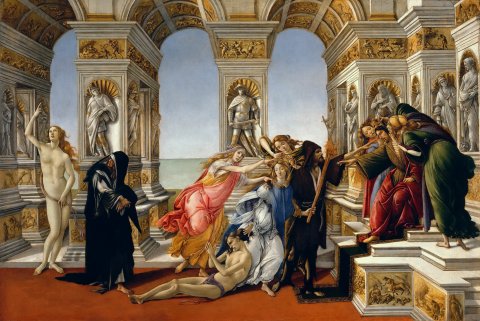Calumny of Apelles - Botticelli
Description
The painter Antiphilos had accused the famous Apelles of participating in an insurrection against Ptolemy IV. Apelles was first imprisoned, then acquitted. Ptolemy gave him Antiphilos as a slave. Apelles then painted a picture allegorising what he had just endured.
In Botticelli's painting, on the right, the king is seated on his throne. Suspicion and Ignorance whisper gossip in his ear. Blinded, the king reaches out his hand and encounters Hatred, wearing a hood and with an abnormally long arm. Behind Hatred, Calumny carries a torch in her left hand. With her right hand, she pulls Innocence, a naked adolescent, by the hair. Deceit and Fraud braid their mistress's hair. Further to the left, an old woman in black represents Repentance. Finally, on the far left, a naked young woman with her right arm raised to the sky, in the posture of Venus rising from the waters, represents Truth.
Here is an excerpt from Lucian's treatise on Apelles:
"We have seen a thousand friendships broken, a thousand houses overturned by these colourful denunciations.
§2. In order to keep us from falling into this trap, I want, in this speech, to retrace, as in a painting, what denunciation is, with its causes and effects. Long before me, Apelles of Ephesus drew this image: he saw himself slandered before Ptolemy as an accomplice in the conspiracy hatched in Tyre by Theodotus. Apelles had never seen Tyre; he knew absolutely nothing about this Theodotus; he had only heard that he was a lieutenant of Ptolemy, to whom the prince had entrusted the government of Phoenicia. However, one of his rivals, named Antiphile, jealous of his favour with the king and envious of his talent, denounced him to Ptolemy as having been involved in the plot, claiming that Apelles had been seen in Phoenicia at table with Theodotus, whispering in his ear throughout the meal. Finally, he asserted that the revolt of Tyre and the capture of Pelusium were the result of Apelles' advice.
§3. Ptolemy, a man of little insight but nourished by the flattery of the courts, allowed himself to be carried away and disturbed by this absurd calumny, without reflecting on its implausibility, without paying attention to the fact that the accuser was a rival, that a painter was too insignificant to be involved in such treachery, especially a painter who had been showered with his favours and honoured by him more than any of his colleagues, without finally inquiring whether Apelles had ever sailed for Tyre, Ptolemy, I say, gave himself over to his fury, filled his palace with his cries, and treated Apelles as ungrateful, a conspirator, a traitor. Perhaps even, if one of the conspirators, arrested for this revolt, indignant at Antiphilus' impudence and moved to compassion for the unfortunate Apelles, had not declared that the latter had taken no part in their plot, perhaps this great painter would have had his head cut off, a victim of the evils that had befallen Tyre and for which he was not to blame.
§4. Ptolemy recognised his mistake and, it is said, regretted it so deeply that he gave Apelles a hundred talents and handed Antiphile over to him to be his slave. Apelles, his imagination filled with the danger he had faced, took revenge for the betrayal with the painting I am about to describe.
§5. On the right sits a man with long ears, like those of Midas: he reaches out his hand from afar to Denunciation, who is approaching. Next to him are two women, undoubtedly Ignorance and Suspicion. On the other side, we see Denunciation approaching in the form of a divinely beautiful woman, but with a flushed, agitated face, as if transported by anger and fury. In her left hand she holds a burning torch; in her right, she drags a young man by the hair, who raises his hands to the sky and seems to call on the gods as witnesses. He is led by a pale, hideous man with a penetrating gaze; he looks like a man emaciated by a long illness. He is Envy personified. Two other women accompany Denunciation, encouraging her, arranging her clothes and taking care of her adornments. The interpreter who introduced me to the allegories of this painting told me that one is Deceit and the other is Perfidy. Behind them walks a woman in a desolate state, dressed in a black, torn dress: she is Repentance; she turns her head away, sheds tears, and looks with extreme confusion at Truth, who is coming towards her. Thus, with his brush, Apelles depicted the danger he had escaped.
§6. Let us now try, following the example of the painter from Ephesus, to describe Denunciation, with all its attributes, and let us begin by defining it: this is the way to make its image even more lifelike... "
The Apelles referred to in this text by Lucian is not the great painter born in Cos who lived under Alexander and Ptolemy, son of Lagos. The one referred to here was from Colophon and, by adoption, a citizen of Ephesus. However, the two painters were confused during the Renaissance.
2. This is Botticelli's last work on a secular subject. Botticelli drew inspiration from a lost painting by Apelles, described by Lucian. This description is considered by Alberti in De pictura (1435) to be the ideal of pictorial composition (book III, §53, ed. Macula p. 213). Could Botticelli have depicted (before his conversion) Savonarola, whose slanderous sermons precipitated the revolution in Florence?
3. Dürer also produced his own version of Apelles' painting as described by Lucian (drawing, 15x44 cm, 1522, Vienna, Albertina).
Technical Data
Notice #000720



